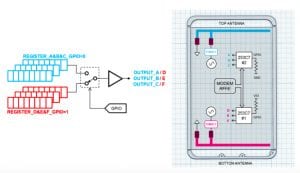Smart-Antenna Controller Cuts Board Space, BoM, and Battery Load
STMicroelectronics has introduced the STHVDAC-253C7 digital controller for tunable capacitors such as ST's STPTIC family. According to ST, the STHVDAC-253C7 shrinks the size, power consumption, and bill of materials (BoM) of antenna-tuning circuits for steadying smartphone RF performance. Using the STHVDAC-253C7 with STPTIC capacitors for frequency tuning and impedance matching almost eliminates the effects of environmental differences, resulting in stronger signal reception, faster data rates, fewer dropped calls, and longer battery life for handset users.
Leveraging ST's advanced 0.18µm BCD8 process and the 0.35mm-pitch flip-chip package, the STHVDAC-253C7 is 50% smaller than its predecessor and uses half the operating current.
In addition, the new controller runs with the latest 0402 chip-size inductors and needs no external Schottky diode, thereby further reducing the overall circuit footprint.
ST specifically designed the high-voltage digital-to-analog converter (DAC) to generate bias voltages for tunable capacitors. Hence, the STHVDAC-253C7 provides three outputs suitable for tuning three different capacitances in multi-band GSM/WCDMA/LTE handsets. ST also integrated the boost converter to generate bias voltages across the full capacitor-tuning range from 0V to 24V.
 HVDAC Logic Diagram Procedure Connection
HVDAC Logic Diagram Procedure Connection
The STHVDAC-253C7 accepts standard MIPI RFFE (RF Front-End) commands from the system transceiver. Support for three RFFE Unique Slave IDs (USID) allows a single STHVDAC-253C7 to manage up to three separate antennas.
The STHVDAC-253C7 supports commonly used antenna-tuning modes, such as Normal mode, which moves to a newly determined output voltage within 10µs; Turbo mode, optimized to minimize settling time; and Glide mode, with a programmable delay from 512µs to 16.84ms for the smooth transitions and to meet requirements such as 3GPP phase discontinuity.
A GPIO pin is provided that can be utilized to manage two controllers on the same RFFE bus in dual-tuner handsets. It also allows switching between registers to control antenna-diversity designs or adjust settings to correct the antenna response when a USB cable is plugged in.
Key Features
- Dedicated controller to bias BST tunable capacitances
- Turbo and Glide Modes for optimal system performance
- Integrated boost converter with 3 programmable outputs (from 0 to 24 V)
- Low power consumption and high accuracy thanks to production trimming
- MIPI RFFE v2.0 serial interface 1,8 V with extended frequency range up to 52 MHz
- Synchronous reads support (sRead)
- 3 USID support in order to control 3 antennas with a single device
- GPIO for Register swap to support DPDT switching and USB cable plugged in
- Available in 350 microns pitch WLCSP for stand-alone or SiP module integration
Production of the STHVDAC-253C7 is ramping up, in the form of a 12-bump 0.35mm-pitch WLCSP flip-chip. Pricing options start from $0.19 for orders of 1000 pieces, and samples are available immediately to support design and development.






